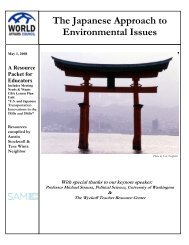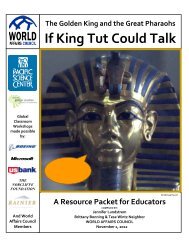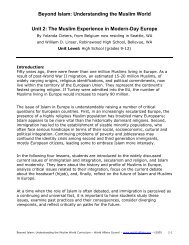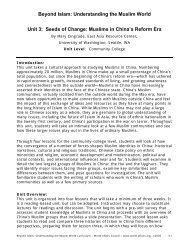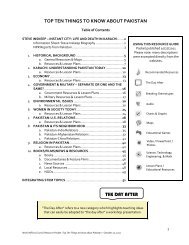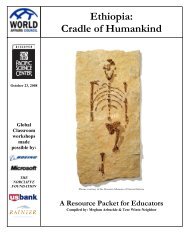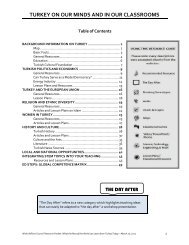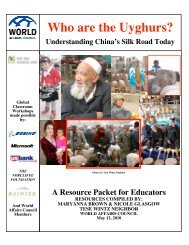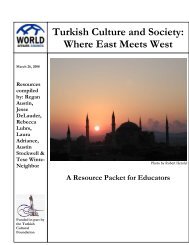The Question(s) of Tibet - World Affairs Council
The Question(s) of Tibet - World Affairs Council
The Question(s) of Tibet - World Affairs Council
Create successful ePaper yourself
Turn your PDF publications into a flip-book with our unique Google optimized e-Paper software.
GLOBAL SANDBOX<br />
<strong>Question</strong>ing the Schedule: Reading about Social Studies in the Elementary Classroom<br />
Eileen Hynes: http://globalsandbox.blogspot.com/<br />
When you talk to elementary school teachers these days about what they are teaching and how<br />
their days with students unfold you may be surprised by the impact <strong>of</strong> the controversial No Child Left<br />
Behind Act (NCLB) on every aspect <strong>of</strong> the average classroom experience. High standards and<br />
accountability make sense in theory and may sound reasonable in federal <strong>of</strong>fices, where there are no<br />
teachers, and no children. <strong>The</strong>re the ideas are translated into priorities for the all‐important funding <strong>of</strong><br />
public education. Ironically, their impact on this most recent generation <strong>of</strong> students comes right at the<br />
time when the importance <strong>of</strong> global awareness as an essential element <strong>of</strong> education should be<br />
increasingly obvious.<br />
If you were asked to choose a discipline that would serve as the bridge that connects all aspects<br />
<strong>of</strong> elementary education, something tells me it would not be test taking. For me, in this rapidly shrinking<br />
world, it would be Social Studies. I see learning about people as the territory in which reading, math,<br />
science and art all come together. And yet, in schools across Washington State, teachers are left with as<br />
little as three forty‐five minute periods a week to teach art, social studies, and science. This is a choice<br />
most schools have made in the hopes <strong>of</strong> improving test scores and demonstrating increased student<br />
learning. Whether preparing for tests is learning has thus far not been demonstrated.<br />
In the present educational environment exemplary teaching can be found in classrooms where<br />
the teachers are willing to go against the grain <strong>of</strong> current trends and school culture. Richard Allington<br />
summarizes the habits <strong>of</strong> these teachers in his article “<strong>The</strong> Six Ts <strong>of</strong> Effective Elementary Literacy<br />
Instruction” (http://www.readingrockets.org/article/96 2002). For students to become pr<strong>of</strong>icient readers they<br />
must spend time reading at a comfortable or “easy” level. That is different for each student. <strong>The</strong> scripted<br />
one‐size‐fits‐all model that continues to gain momentum is the exact opposite <strong>of</strong> what kids need.<br />
Classrooms should be filled with books at appropriate levels and kids should spend time reading<br />
throughout the day. With a little bit <strong>of</strong> extra effort a teacher can put together book boxes that change<br />
every six weeks or so around the theme <strong>of</strong> an integrated study (Social Studies!). <strong>The</strong> class can all be<br />
reading books about the same topic, not the same book. <strong>The</strong> <strong>World</strong> <strong>Affairs</strong> <strong>Council</strong> Global Classroom is<br />
one place teachers can turn to find relevant resources and information, including book lists, organized<br />
around topics that support a vibrant social studies curriculum for elementary classrooms.<br />
A study <strong>of</strong> the <strong>Tibet</strong>an Plateau, the ro<strong>of</strong> <strong>of</strong> the world, is a place where social studies and science<br />
come together. Through the use <strong>of</strong> maps and geography skills young students can begin to think about<br />
the significance <strong>of</strong> a place that holds the most ice <strong>of</strong> any place besides the Polar Regions. <strong>The</strong> fact that<br />
this ice is the source <strong>of</strong> the major rivers <strong>of</strong> Asia, which provide drinking water for over two billion people<br />
makes for very interesting reading, at any level.<br />
Check out “<strong>The</strong> Big Melt” by Norwegian<br />
photographer Jonas Beniksen for a visual<br />
overview <strong>of</strong> the significance <strong>of</strong> the <strong>Tibet</strong>an<br />
Plateau on the planets water supply.<br />
(http://ngm.nationalgeographic.com/video/playe<br />
r#/?titleID=water‐thirsty‐world&catID=1)<br />
I would use a book like A Drop Around the <strong>World</strong> by Barbara McKinney (1998) along with two<br />
beautiful books by Thomas Locker, Mountain Dance (2002) and Water Dance (2002) to stimulate class<br />
discussions about water. Once the group has spent some time looking at the maps and identifying the<br />
major rivers I would begin to ask questions about the people who live in this unique environment. I would<br />
share <strong>Tibet</strong>an Tales from the Top <strong>of</strong> the <strong>World</strong> by Naomi Rose (2009) to begin a discussion <strong>of</strong> <strong>Tibet</strong>an<br />
culture. Another book that I would be sure to include in my classroom study would be <strong>The</strong> Chiru <strong>of</strong> High<br />
<strong>Tibet</strong> by Jacqueline Briggs Martin (2010) that tells the true story <strong>of</strong> these endangered animals and the<br />
people who are trying to protect them.<br />
<strong>World</strong> <strong>Affairs</strong> <strong>Council</strong> Teacher Resource Packet – <strong>The</strong> <strong>Question</strong>(s) <strong>of</strong> <strong>Tibet</strong> February 28, 2011<br />
28



